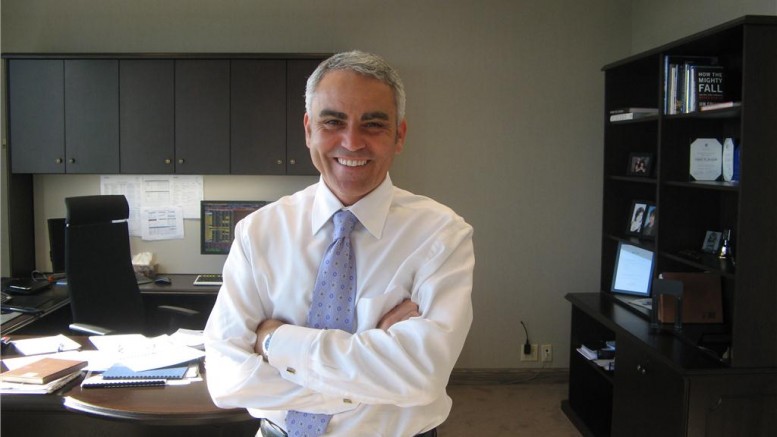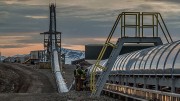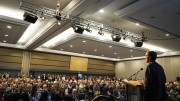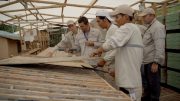VANCOUVER — Goldcorp (TSX: G; NYSE: GG) is looking to invest $100 million in a portfolio of junior explorers that have early stage projects with district-scale potential, Goldcorp president and CEO David Garofalo said during a presentation at this year’s Association for Mineral Exploration Roundup convention in Vancouver.
The investments would be made through private placements, rather than acquiring positions in the open market, and preference would be given to companies focused on the Americas, he added.
Garofalo, who joined Goldcorp in February last year, introduced a similar investment strategy, called the “farm system,” to Hudbay Minerals (TSX: HBM) during his tenure as the company’s president and CEO.
Out of the 15 to 20 juniors in which Hudbay had small but significant stakes, Norsemont Mining and its Constancia copper-gold deposit in Peru came out on top. Hudbay acquired the entire company in 2011 for $362.8 million, and Constancia became Hudbay’s first major mining operation outside Canada.
“By and large, the major producers in our sector don’t do a great job at greenfield exploration,” Garofalo told the Vancouver crowd. “We’re good at derisking projects, building mines and optimizing those operations over time, but the exploration game is an entirely different risk profile that requires a different set of skills — skills that junior explorers have.
“Explorers are effective at accumulating land around geologically prospective belts. They’ve done the geochemical and geophysical work and have generated good targets, but they need money to drill those targets, and that’s where we would come in,” he said.
The international gold miner has already spent the past year scooping up interests in a number of junior explorers.

The camp at Sirios Resources’ Cheechoo gold property, next to Goldcorp’s Éléonore gold mine in Quebec. Goldcorp invested $1 million in the junior last year. Credit: Sirios Resources.
In February 2016, the company injected $16.1 million into Gold Standard Ventures (TSXV: GSV; NSYE-MKT: GSV) to gain exposure to the junior’s Railroad-Pinion gold project in Nevada’s prolific Carlin trend, and $1 million into Sirios Resources (TSXV: SOI) for its flagship Cheechoo gold property next to Goldcorp’s Éléonore gold mine in Quebec.
By May, Goldcorp had bought all of Kaminak Gold for $520 million for its 5.2 million oz. Coffee gold project in the Yukon.
One month later, the company extended its reach in the Yukon by spending $1.5 million for a 19.9% stake in Independence Gold (TSXV: IGO), which has the Boulevard gold project next to Coffee.

Geologists in the field at Auryn Resources’ Committee Bay gold property in Nunavut. Credit: Auryn Resouces.
The latest addition to Goldcorp’s portfolio is a stake in technically driven Auryn Resources (TSX: AUG; US-OTC: GGTCF). In January, Goldcorp invested $35 million into the explorer for its promising Committee Bay gold project in Nunavut and gold projects in southern Peru.
“The past couple of years we’ve been in a capital-spend cycle, building up Éléonore and Cerro Negro, but now that we’re harvesting those returns we have to invest back in exploration,” Garofalo said. “We’ve taken a number of interests in junior companies, with the view of cultivating our portfolio with opportunities that could grow into something more meaningful.”
Goldcorp is after “large, long-life deposits” in prospective districts that could grow to at least 5 to 10 million oz. gold through brownfields discovery, and deliver up to 500,000 oz. in annual production, he said.
If such a project eventually fails to meet Goldcorp’s size criteria, Garofalo said his company would “recover [cents] on the dollar and recycle that capital into another junior.
“What we’re doing is a far more cost-effective way to do exploration, but it’s also risk-effective, too, because we’d diversify risk across 15 to 20 names,” he added.
While Garofalo wouldn’t comment on any projects Goldcorp may be interested in, there are at least a few companies that could fit the bill.

Marathon Gold’s CEO Phillip Walford collects a sample at the Valentine Lake gold project in Newfoundland. Credit: Marathon Gold.
Marathon Gold (TSX: MOZ) is one potential contender to receive a cash plug from the international miner. The junior explorer is working towards a preliminary economic study at its Valentine Lake gold project in central Newfoundland. The project hosts over 1 million oz. gold within four orogenic-style deposits, while the rest of its largely unexplored 240 sq. km land package covers a 20 km strike length of prospective structures.
Stratton Resources (TSXV: SI) also holds a significant land position in Newfoundland that may be attractive for Goldcorp. In November last year, Stratton acquired 1,190 sq. km of ground from Shawn Ryan’s Wildwood Exploration. Ryan had picked up the ground shortly after striking a deal with G4G Capital (TSXV: GGC), which offered G4G the option to buy all of Ryan’s other gold properties, totalling 2,490 sq. km, in the Yukon’s prospective White Gold district. Stratton’s chairman and interim president and CEO is Shawn Wallace, who also serves as president and CEO of Auryn Resources. Stratton recently completed a $13-million private placement that will be used to fund exploration, further property acquisitions and general corporate purposes.
Aurion Resources (TSXV: AU) could give Goldcorp a toehold in Finland’s Central Lapland greenstone belt, a package of rocks similar to those seen within the gold-prolific regions of Ontario and Quebec. The prospector generator is building momentum at its 100% owned, 140 sq. km Risti project after announcing the discovery of bonanza-grade gold mineralization on Feb. 2. Since last year, the company has discovered a 1,100-metre (1.1 km) by 700-metre gold mineralization zone, with 133 grab samples averaging 74.3 grams gold per tonne.
TerraX Minerals (TSXV: TXR; US-OTC: TRXXF) and Nighthawk Gold (TSXV: NHK; US-OTC: MIMZF) both have large land positions covering prospective greenstone belts in the Northwest Territories. TerraX is testing gold-continuation structures south of the former 5 million oz. Con mine, with 17,000 metres of drilling at its Southbelt property outside Yellowknife. The junior explorer recently staked another 253 sq. km of claims, which brings its total land position in the greenstone belt up to 382 square kilometres.

Nighthawk Gold’s Colomac gold deposit in the Northwest Territories. Credit: Nighthawk Gold.
Nighthawk is searching for a Kalgoorlie look-alike at its 899 sq. km Indin Lake gold property 200 km north of Yellowknife. Indin Lake hosts the former Colomac gold mine, which saw over 500,000 oz. gold produced between 1990 and 1997 at grades of 1.7 grams gold. Colomac still hosts 2 million oz. gold in 38.1 million inferred tonnes of 1.67 grams gold. The project has already gained the interest of Kinross Gold (TSX: K; NYSE: KGC) after a $10.1-million cash injection last November, which gave Kinross a 9.5% stake in Nighthawk.
While Goldcorp favours projects with low political risk, Garofalo hinted that “socially complex” regions may also be on the company’s radar.
“There are some large-scale deposits that are sitting in privates or juniors, but they don’t have the capital or technical capabilities to advance those projects further, and are generally socially complex, so you can’t build those mines overnight,” he said. “Nobody wants to hold any of those projects on their own … you’ll need potentially two or three companies working collaboratively to advance and derisk those projects over time.”
One such example could include Lumina Gold’s (TSXV: LUM) Cangrejos and Condor projects in southern Equador. Cangrejos hosts a porphyry copper-gold deposit with upwards of 4 million oz. gold in inferred resources, whereas the Condor project, located 31 km south of Lundin Gold’s (TSX: LUG; US-OTC: FTMNF) 7.4 million oz. Fruta del Norte gold project, hosts an epithermal system that contains 10.6 million oz. gold.
“If you look at the top-three producers in the world — including Goldcorp, Barrick and Newmont — collectively and individually over the last five years we’ve seen our reserves decline by a third,” Garofalo said. “That downward dynamic in gold reserves is not sustainable, and risks making the sector irrelevant to particular investors, so we have to turn that dynamic around as an industry. And to do that we have to collaborate among the senior ranks to cultivate a growing reserve base … all of the market leaders have to invest back into the ground in a collaborative fashion to reverse that downward trend.”

Location map showing Goldcorp’s current operations and major projects. Credit: Goldcorp.
This strategy is part of Goldcorp’s five-year plan to increase its production 20% to 3 million oz. gold, boost reserves 20% to 50 million oz. gold, and lower all-in sustaining costs 20% to US$700 per oz. gold.
As the company tones down greenfields exploration, brownfields work around its existing operations will continue.
Goldcorp’s mines are Musselwhite, Red Lake and Porcupine in Ontario, Éléonore in Quebec, Penasquito in Mexico, Pueblo Viejo in the Dominican Republic — in which it owns 40% — and Cerro Negro in Argentina. Potential large-scale camps in the company’s portfolio include NuevaUnion in Chile — a fifty-fifty joint venture with Teck Resources (TSX: TECK.B; NYSE: TECK) — and Coffee in the Yukon.






Be the first to comment on "Roundup 2017: Goldcorp scouts out investments in juniors"